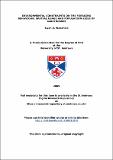Environmental constraints on the foraging behaviour, spatial usage and population sizes of albatrosses
Abstract
Satellite-tracking of wide-ranging, apex marine predators, combined with remote-sensing, can be used to test ecological hypotheses and to estimate spatial abundance. I
used this approach to quantify the habitat usage of central place foraging black-browed
albatrosses (BBA) from nine colonies, modelling population-level distribution as a
function of habitat accessibility, habitat preference and conspecific competition.
Throughout breeding, BBA preferred neritic waters, steeper bathymetry, and, during
incubation, warmer sea surface temperatures. BBA from South Georgia also preferred
highly dynamic oceanic waters. Foraging areas were partially spatially segregated with
respect to colony and region, presumably to reduce intraspecific competition. Although
such competition is often invoked to explain observed colony sizes, by accounting for
travel costs, I demonstrate a strong relationship between the sizes of regional
populations and the availability, accessibility and productivity of neritic waters,
supporting the hypothesis that seabird populations are constrained by breeding season
food availability. In response to this constraint, albatrosses have evolved to exploit
energetically efficient gliding flight, allowing them to access prey 100-1000s of km
from their colonies. Hence, I used satellite tracking and activity data to quantify the
effects of relative wind speed on the flight speed of four albatross species.
Groundspeed was linearly related to the wind speed in the direction of flight, its effect
being greatest on wandering albatrosses, followed by BBA, light-mantled and grey-
headed albatrosses, and airspeeds were higher in males than females. Commuting birds
tended to encounter headwinds during outward trips and tailwinds on their return, such
that return trips were faster. This supports the hypothesis that foraging upwind of the
colony is more efficient but could also result from wind climate and the relative
location of prey. The ability to use tracking data to estimate spatial usage is timely
given the acute threat currently posed to albatrosses by incidental fisheries mortality.
Type
Thesis, PhD Doctor of Philosophy
Collections
Items in the St Andrews Research Repository are protected by copyright, with all rights reserved, unless otherwise indicated.

